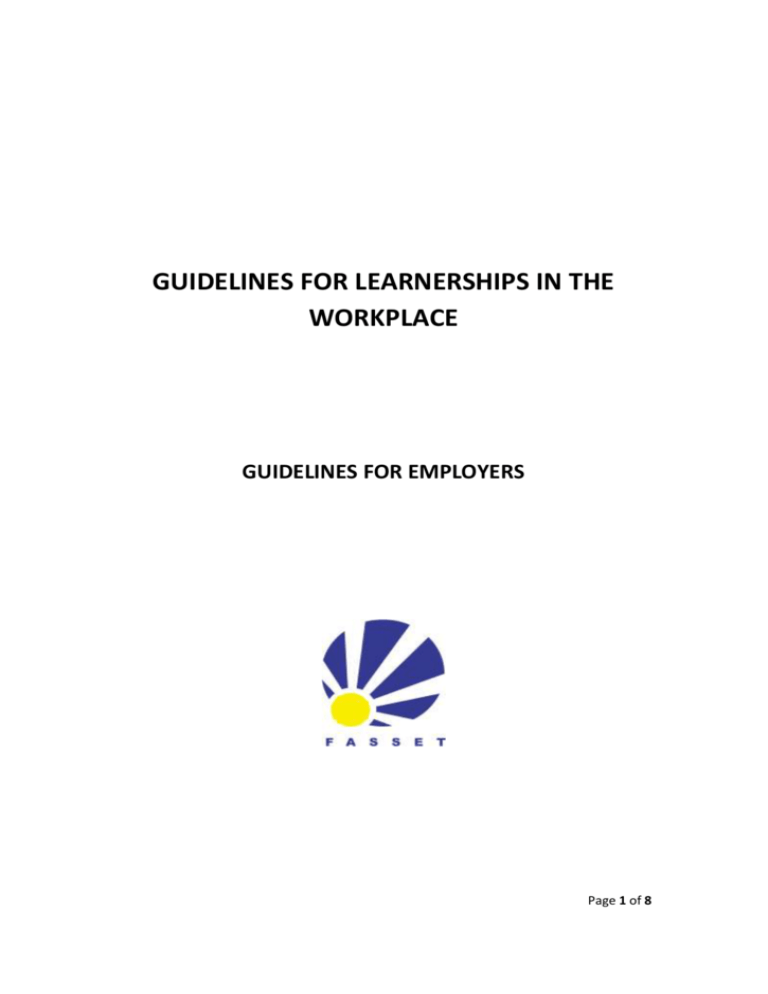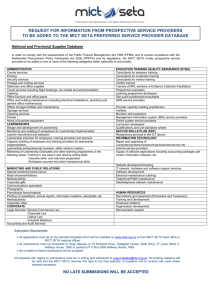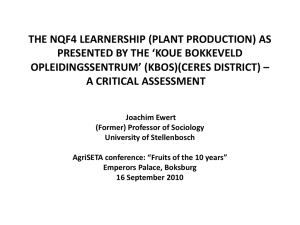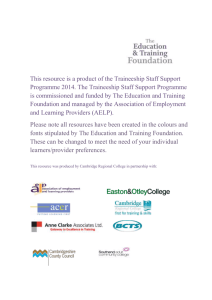What is a learnership?
advertisement

GUIDELINES FOR LEARNERSHIPS IN THE WORKPLACE GUIDELINES FOR EMPLOYERS Page 1 of 8 CONTENTS 1 General information ................................................................................................ 1 1.1 What is a learnership? ............................................................................................. 1 1.2 What are the benefits to an employer?................................................................... 1 1.3 What is expected of an employer? .......................................................................... 1 1.4 What is expected of a learner? ................................................................................ 2 1.5 Learnership agreement ............................................................................................ 2 1.6 Contract of employment .......................................................................................... 2 1.7 Registering the learnership with a SETA .................................................................. 3 1.8 Financial implications of a learnership .................................................................... 3 1.8.1 Costs ................................................................................................................ 3 1.8.2 Financial support ............................................................................................. 4 1.9 Accreditation as a workplace provider .................................................................... 4 1.10 Coaching and mentoring of learners in the workplace............................................ 4 1.10.1 What is coaching and mentoring?................................................................... 4 1.10.2 Selection of mentors ....................................................................................... 5 1.11 Employers’ responsibility regarding assessments ................................................... 5 1.12 Employers’ responsibilities regarding record keeping ............................................. 6 Page 2 of 8 General information What is a learnership? A learnership is a structured learning programme that consists of a theoretical and a practical component and that leads to a qualification that is registered on the National Qualifications Framework (NQF). Learnerships are governed by the Skills Development Act (Act 97 of 1998), by a number of subsequent regulations and by the policies and procedures of the Sector Education and Training Authorities (SETAs). A learnership is regulated by a formal contract (learnership agreement) between an employer, a learner and a training provider. An employer can enter into learnership agreements with existing employees or with learners who are not employees. If the employer enters into a learnership agreement with a learner who is not an employee the employer is not obliged to employ the learner when the learnership ends. What are the benefits to an employer? The potential benefits of training learners on learnerships to an employer are numerous: The structured learning programme of a learnership can assist employers in developing a welltrained and committed workforce. Staff members are trained towards a nationally recognised qualification and this may lead to more motivated and dedicated employees. Employers get to know and assess learners and have the opportunity to screen them for permanent employment without the obligation to employ them. Financial benefits in the form of tax deductions and SETA grants. What is expected of an employer? An employer who wants to enter into a learnership contract with one or more learners has to: be accredited as a workplace training provider with the SETA to which the skills development levy is paid recruit and select learners for the learnership programme provide the learner with the necessary workplace experience, supervision and mentorship for the particular learnership release the learner to attend training at the training provider or, if the learner studies through distance education, to work through the relevant study material ensure that the learner will be assessed by a registered assessor. Page 1 of 8 What is expected of a learner? The learner who enters into a learnership agreement is expected to participate in induction programs work for the employer as part of the learning process register with a training provider and / or professional body l be available for and participate in all learning and work experience required by the learnership comply with the employer’s work place policies and procedures complete any timesheets/log books or written assessment tools supplied by the employer or the training provider and / or professional body attend all study periods and theoretical learning sessions with the training provider and / or professional body undertake all learning conscientiously and set aside sufficient time for self-study undergo all practical and theoretical assessments for the learnership. Learnership agreement The learnership agreement is a formal agreement that is entered into by the learner, the employer and the training provider, if applicable. The agreement must be in the prescribed format and must be registered with the SETA with which the employer is registered. Contract of employment Section 18 of the Skills Development Act determines that: (1) If a learner was in the employment of the employer party to the Iearnership agreement concerned when the agreement was concluded, the learner’s contract of employment is not affected by the agreement. (2) If the learner was not in the employment of the employer party to the learnership agreement concerned when the agreement was concluded, the employer and learner must enter into a contract of employment. The contract of employment specified in (2) above, ends when the learnership agreement ends. Page 2 of 8 Registering the learnership agreement with a SETA The employer is responsible to register the learnership agreement with the SETA the employer is registered with. Employers registered with Fasset must submit the Learnership Agreement to Fasset, and ensure the following: Include proof of learner registration with a training provider and / or professional body (student number) Include proof of employer workplace accreditation status with Fasset or the relevant professional body (copy of letter/certificate) Levy payments to SARS are up to date (for the purpose of grant applications) Skills Development Plan has been submitted and approved (for the purpose of grant applications) Fasset will provide the employer with proof that learners are registered via an official confirmation letter that will include the following details: Seta Name and Code Employer Organisation details with Levy Number DHET Learnership Title DHET Learnership Code Full Name of Learner Learner ID Number Learnership Agreement Classification 18 (1) employed OR 18 (2) unemployed Date of Commencement of Learnership Date of Completion of Learnership Financial implications of a learnership Costs The following direct costs are generally incurred during a learnership: Tuition costs (fees payable to training provider) Professional registration fees (if applicable) Learner allowances (previously unemployed learners) Assessment costs (if external assessors are used). Page 3 of 8 Financial support Government support for learnerships is available and includes the following: Tax deduction Exemption from SDL and UIF payments for learners Employment Tax Incentive (refer to the SARS website) BBBEE Score enhancement (refer to the DTI website) SETA grants. Employers who are not registered with Fasset are referred to their own SETAs for information on their grants. Accreditation as a workplace provider For a learnership there are providers of the theoretical learning component as well as providers of the workplace and practical learning component. All training providers have to comply with the quality requirements of the QCTO and Fasset. Compliance with the quality requirements is ensured through a process of accreditation. All training providers (theoretical as well as workplace providers) have to apply for accreditation with the relevant Quality Assurance Body (QAB). A provider can only be accredited by one QAB. The QAB must have the same focus area as the provider. If a company, not belonging to Fasset, is interested in offering the learnership in debt recovery, this company should contact the SETA they are registered with. That SETA will liaise with Fasset. The two SETAS will conclude, if not already done, a memorandum of understanding (MoU) in terms of quality assurance. Once the company signs the learnership agreement, it will be registered with the SETA the company belongs to and not with Fasset. All official documentation will reside with that SETA and not with Fasset. Fasset will however remain responsible for the quality assurance of the learnership and associated qualification. Coaching and mentoring of learners in the workplace What is coaching and mentoring? Coaching/mentoring is a form of learning requiring a more experienced individual providing and sharing their knowledge directly with the individual. Coaching usually provides the most direct approach to acquiring knowledge and is most appropriate for skills-based instruction. When combined with a structured learning program, coaching is one of the best methods of reinforcing new habits. Mentoring is a one-to-one relationship based on encouragement, constructive comments, openness, mutual trust, respect, and a willingness to learn and share. It exists between a more experienced employee (sometimes, but not necessarily, a supervisor) and a less experienced employee (e.g. a Page 4 of 8 learner). The mentor is a model, a motivator and a counsellor to the learner. The mentor's responsibilities include: helping the learner set long-term career goals and short-term learning objectives helping the learner understand the organisational culture recommending and/or creating learning opportunities transferring knowledge in areas such as communication, critical thinking, responsibility, flexibility, and teamwork pointing out strengths and areas for development answering any questions, and providing guidance on personal matters. Selection of mentors Mentors will often have very different personality or management styles but should have several characteristics in common. A good mentor: is an established employee understands the organisation and its culture is available and willing to spend time with the student, giving appropriate guidance and feedback enjoys helping others is open-minded is flexible, empathetic, and encouraging has very good communications skills, and stimulates the student's thinking and reflection. Employers’ responsibility regarding assessments Employers are responsible for the final assessment of learners. This assessment normally takes place in the workplace. Assessments must be performed by an assessor who is registered with Fasset as an assessor for the particular learnership. Assessors may be internal to the organisation or the employer may source the services of an external assessor. Assessors must be subject matter experts (i.e. must Page 5 of 8 have knowledge of the technical field) and they must have achieved the unit standard for assessors before they will be registered as assessors. Employers’ responsibilities regarding record keeping Original or copies of the following forms should be kept on record: learner agreements/contracts standard forms and reports (SETA, employer or provider specific) assessment guides training manuals employment contracts code of conduct certificates grievance and appeal discussions/proceedings progress reports placement records In reporting, the employer must ensure that: the information is valid and reliable the information is thorough and convincing recommendations are practical and achievable all stakeholders suggestions and recommendations are included Some organisations may have existing computer-based information systems that will be utilised for record keeping. In some instances however a manual system may be created. It is the responsibility of both the employer and the provider to adapt management and administration systems to accommodate learnerships, and also to co-ordinate information between the two sites of learning. It is advisable to maintain a personal file for each learner. Page 6 of 8








